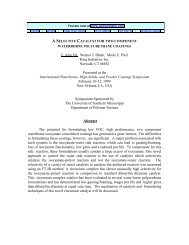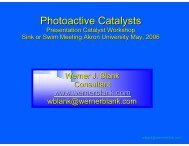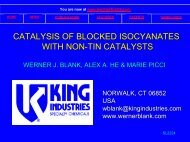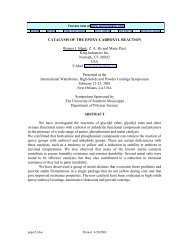Catalysis of the Isocyanate-Hydroxyl Reactions ... - Wernerblank.com
Catalysis of the Isocyanate-Hydroxyl Reactions ... - Wernerblank.com
Catalysis of the Isocyanate-Hydroxyl Reactions ... - Wernerblank.com
You also want an ePaper? Increase the reach of your titles
YUMPU automatically turns print PDFs into web optimized ePapers that Google loves.
Introduction<br />
The catalysis <strong>of</strong> <strong>the</strong> isocyanate-hydroxyl reaction has been studied by many authors 1 who found<br />
that <strong>the</strong> reaction <strong>of</strong> aliphatic isocyanates with hydroxyl groups is catalyzed by many metal<br />
carboxylates and organo tin <strong>com</strong>pounds. t-Amine catalysis <strong>of</strong> <strong>the</strong> reaction <strong>of</strong> aromatic<br />
isocyanates with hydroxyl groups has been practiced for some time and is <strong>com</strong>mon for <strong>the</strong><br />
preparation <strong>of</strong> flexible polyurethane foams 2 . This paper also describes <strong>the</strong> formation <strong>of</strong><br />
isocyanurate trimer and <strong>the</strong> side reaction with water. This side reaction with water is a desirable<br />
reaction for foam applications because <strong>the</strong> thus formed carbon dioxide can be used as a blowing<br />
agent. In most coating applications side reaction with water is not desirable because it can lead to<br />
gassing and blister formation and also to poor crosslinking density. The water reaction <strong>of</strong><br />
isocyanates is especially troublesome during cure under high humidity conditions or in two<br />
<strong>com</strong>ponent water-borne isocyanate crosslinked coatings. The reaction <strong>of</strong> 4,4-<br />
dicyclohexylmethane diisocyanate in <strong>the</strong> presence <strong>of</strong> dialkyltin <strong>com</strong>pounds with water and<br />
alcohols was investigated 3 in triethylene glycol dimethyl e<strong>the</strong>r and n-methyl pyrrolidinone. This<br />
study found selectivity 4 <strong>of</strong> <strong>the</strong> hydroxyl versus water reaction <strong>of</strong> between 1.8 to 3.8 depending on<br />
reaction conditions. One exception was dibutyltin dichloride which gave equal rate constants for<br />
both n-butanol and water. The steric hindrance around <strong>the</strong> catalytic center was found to have<br />
strong effects on <strong>the</strong> rate constants for urethane reactions catalyzed by sulfonium catalysts 5 . In<br />
<strong>the</strong> cyclotrimerization reaction, this effect on <strong>the</strong> reaction rate was negligible. The reaction 6 <strong>of</strong><br />
isophorone diisocyanate with alcohols was studied in <strong>the</strong> absence and presence <strong>of</strong> dibutyltin<br />
dilaurate (DBTDL) and 1,4-diazabicyclo[2,2,2]-octane (DABCO). In <strong>the</strong> presence <strong>of</strong> DBTDL <strong>the</strong><br />
reaction <strong>of</strong> <strong>the</strong> secondary isocyanate groups was favored, while in <strong>the</strong> presence <strong>of</strong> DABCO <strong>the</strong><br />
reaction <strong>of</strong> <strong>the</strong> primary isocyanate group was preferred. Apparently <strong>the</strong> relative reactivity <strong>of</strong> <strong>the</strong><br />
isocyanate group depends on <strong>the</strong> mode <strong>of</strong> catalysis and steric hindrance. The reaction <strong>of</strong> water<br />
with aromatic polyisocyanates is <strong>of</strong> interest in <strong>the</strong> formation <strong>of</strong> polyurethane foams. This<br />
reaction 7 was studied in diglyme with amine and tin catalysts. Dibutyltin dilaurate and DABCO<br />
gave equal reaction rates with water and hydroxyl groups. Phenylmercuric acetate showed<br />
exceptional high reaction rates with water. Surprisingly only 70% <strong>of</strong> <strong>the</strong> water was found to<br />
contribute to carbon dioxide evolution. In water-borne two <strong>com</strong>ponent coatings 8 <strong>the</strong> formation <strong>of</strong><br />
urea is a major side reaction. The reaction <strong>of</strong> polyisocyanates in water-borne two <strong>com</strong>ponent<br />
coatings 9 in <strong>the</strong> presence <strong>of</strong> different amines was investigated. It was observed that <strong>the</strong> pK a value<br />
<strong>of</strong> <strong>the</strong> amine has a large effect on <strong>the</strong> water-isocyanate reaction and that amines with a higher pK a<br />
value show increased reactivity <strong>of</strong> <strong>the</strong> isocyanate with water.<br />
Dibutyltin <strong>com</strong>pounds are generally recognized to function as Lewis acid catalysts by<br />
<strong>com</strong>plexing with <strong>the</strong> isocyanate 10 . The mechanism <strong>of</strong> catalysis <strong>of</strong> amines has been related to<br />
Lewis base catalysis, <strong>the</strong> amine <strong>com</strong>plexing <strong>the</strong> alcohol. Indeed a synergistic effect 11 <strong>of</strong> tin<br />
<strong>com</strong>pounds with amines has been observed in urethane formation. The observation that <strong>the</strong><br />
urethane groups formed catalyze 12 <strong>the</strong> hydroxy/isocyanate reaction <strong>com</strong>plicates in establishing a<br />
catalysis mechanism.<br />
We were interested to develop a catalyst which predominately catalyzes <strong>the</strong> isocyanate-hydroxyl<br />
reaction and not <strong>the</strong> water-reaction. A suppression <strong>of</strong> <strong>the</strong> water reaction could permit <strong>the</strong><br />
formulation <strong>of</strong> water-borne isocyanate crosslinked coatings with an improved potlife, a reduction<br />
in <strong>the</strong> isocyanate index and also permit a reduction in variation in crosslink density with aging <strong>of</strong><br />
<strong>the</strong> formulation.










